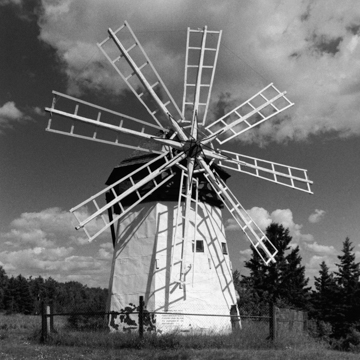A rare example of a gristmill designed in the northern European manner, this structure was built by Davidson with the help of his neighbors on his eighty-acre homestead along the Amnicon River. He had been a millwright in his native Finland and designed this mill like those there. Finns call them “smock mills,” because they look something like a man wearing a smock and a cap. It took four years for Davidson to hand hew the timbers, haul in a thirty-foot-tall tamarack for the main shaft, cut and transport huge granite millstones from the Amnicon River, fashion the gear teeth out of birch roots, and cut the sheet metal blades. The result was a tapered octagonal structure, sheathed in sheet metal. Each of the mill’s faces is eight feet wide at the base, tapering to five feet at the top of the twenty-foot tall shaft. An octagonal turret consists of hand-hewn pine logs, capped with a shingled, conical roof. The turret rests on a track, and steel rollers allowed Davidson to turn it so that its eight blades faced squarely into the prevailing winds.
Inside, the mill has three levels. The main floor houses the gear assemblies and an area where the milled grain collected. The second floor encloses grain hoppers and two sets of millstones. (The four-foot-diameter millstones were for rough milling, and the six-foot-diameter ones produced a finer grind.) The third level contains the wind shaft, the brake wheel, and the main drive gear. All these mechanisms are original and reportedly operational, although the mill has stood idle since 1926. Until then, Davidson’s mill served farmers from as far as ten miles, with mill capacity peaking at forty barrels per day. When improved roads in the 1920s provided better access to larger mills in Superior, Davidson could no longer compete. His descendants own and maintain the structure, but in 1940, its caretakers removed the sheet-metal sails that hung from the latticework blades, as well as the platform that encircled the second level.















